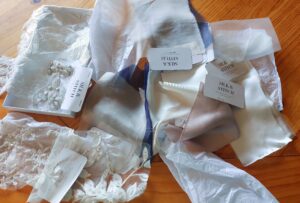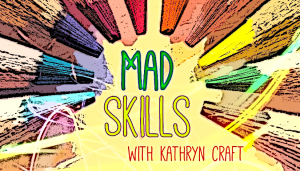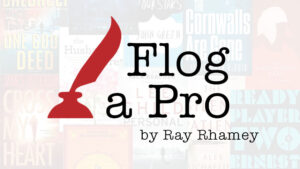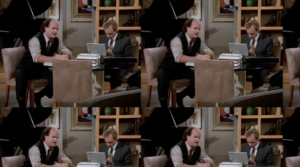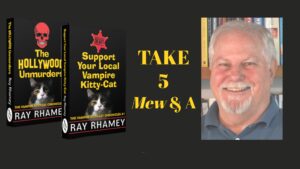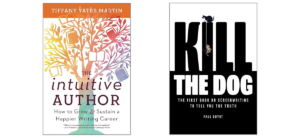Book Talk
When it comes to creating a believable setting or background for a work of fiction, sensory inspirations are very important. Writers need to evoke a world in the reader’s mind which doesn’t just involve the visual and the auditory, but also hopefully bring the other senses into play—touch, smell, taste. It’s always been important to me, as I’m sure it is for many other writers, to experience the atmosphere of places I’m evoking through my stories: I like to actually walk in their streets, to see small details, to hear the soundscapes, whether that be birds, sirens, music, machines, to listen to the tone of voices. I like to experience the smells—good or bad, strong or faint—of those places, and their tactile textures, and the taste of the food you might find there. The sensory impressions you gain from all of it are invaluable. Even if a place is imaginary, I always base it on real locations, so the sensory aspects still ring true. And that means also being able to call up those impressions even when you are back home, and not just through your memory, but through aids such as notes, photos, and video and audio clips.
That works well for the visual and auditory aspects. But what about the other senses—touch, smell, taste? Their effect cannot be fully recaptured through photos, notes, or video/audio. More ephemeral than the visual or the auditory, those three senses are nevertheless crucial to evoking atmosphere: think for example of Proust’s famous madeleines. And it’s not just about place—it’s also about many other elements in a story that will make your fictional world feel absolutely real in a reader’s mind. How, for example, to describe the taste of a dish, if you haven’t tried it? How can you evoke the scent of a particular perfume, if you’ve never smelled it? Or the feel of a particular fabric, if you’ve never touched it?
For me, the answer is to collect concrete objects that bring my story-brain into direct hands-on contact with the sensory experience itself. Over the years I’ve done a lot of that. For example, for a novel I’ve been working on, I needed to understand how different types of silk fabric and lace embellishments might interact with each other and be used in design. I didn’t just rely on my imagination, my lived knowledge of how silk feels against the skin and my observation of a seamstress at work. I also purchased a range of fabric and lace samples which would enable me to see and feel first-hand just how a particular design might work with types of silk fabric. For the same novel, where there is a small but significant mention of the perfume Joy, I didn’t just rely on my memory of my beautiful grandmother’s favourite scent, I managed to find a miniature bottle of the vintage fragrance online, so I could experience the full power of it, and be able to describe it properly. Similarly, in another novel, recently published, where I wrote about the look, smell and feel of various flowers, I needed to actually have some on hand so I could accurately evoke them. In yet another novel, which is centred around food, I didn’t just cook several […]
Read More
Books have been getting a lot of bad press lately. According to Penn America’s website, pen.org, more than 16,000 book bans have been implemented in U.S. public schools since 2021, 4,000 of which occurred in the 2023-2024 school year alone—more than at any other time since the McCarthy era of the 1950s. Public libraries have been under assault as well, with many people questioning their relevance and even advocating for their closure.
Estimates vary as to when books as we know them were first produced, but for the majority of time since the middle of the 15th century, when the invention of the printing press made them available to common people, books were considered precious objects by those who owned them.
The idea that books were treasures held true well into the 20th century, a fact I was reminded of recently when I pulled a few antique volumes off of a shelf in my living room. These clothbound gems, a couple of which were published in the mid-1800s, are marvels to behold.
The first in a two-volume set, Ruins of Ancient Cities by Charles Bucke, published in 1848 by Harper & Brothers of New York, features a detailed etching of ancient Athens across from its title page. The indentations made by the printing press on the book’s pages can still be seen if you look at its elegant serif typeset at just the right angle, a reminder that someone painstakingly set the type for all 360 pages by hand, a feat of craftsmanship few people living today could accomplish without error.
Perhaps even more impressive is Everyman’s Library: A Short Biographical Dictionary of English Literature by John W. Cousin. Published by E.P. Dutton & Co. of New York in 1910, the book’s endpapers feature a gorgeous, scrolling Edwardian design complete with a rendering of the Roman goddess Flora who symbolizes abundance. The publisher’s advertisement for the rest of the Everyman series at the beginning of the book is just as lovely, its type arranged to resemble a stylized tulip.
In my mind’s eye, I can picture the families who once owned these books, sitting in their living rooms, reading passages to one another aloud. Back when these hardcovers were published, reading often felt like an adventure. These books were prized possessions, not just because of their content, but because they were well made, beautiful to look at, and expensive to buy. Books like these said something about the people on whose shelves they were stored.
With their flimsy cover stock and recycled paper pages, modern-day print books, by contrast, often feel disposable. And although they are convenient to buy and read, and better for the environment, electronic books are like ghosts even in comparison to these, gone at the touch of a button.
Of course, the format of modern books makes them affordable and widely available to large numbers of readers. And the myriad types of other media readily accessible online makes it unlikely that books will ever regain the status they once enjoyed on a large scale.
Not unlike the American Arts and Crafts movement of the late 19th and early 20th centuries—a […]
Read Morephoto adapted / Horia Varlan
After a string of heavy reads last fall, I wanted to get swept away in some pure entertainment. I figured the light pink, flowery cover of the 2016 mega-seller by a romance author I hadn’t yet read would fit the bill.
Colleen Hoover’s It Ends with Us did not deliver on the promise of its cover. While the opening did offer a familiar boy-meets-girl moment, I was denied the escapism I sought when the plot evolved toward domestic abuse. Despite the genre switch-up, Hoover did deliver a story that “powerfully illustrates the devastation of abuse—and the strength of the survivors,” as its starred Kirkus review claimed.
This critical three-star Amazon review, though, from reader KieraAnne, speaks to the point of this post:
It didn’t really happen like you’d think. There weren’t TONS of red flags she was ignoring (although there were several), so the first time, it really caught you off guard. It was so much later in the story than I expected that, as a reader, I had grown complacent, so it was shocking when it happened, just as it was to Lily. It was easy to see why someone would explain it away and move forward with the relationship.
KieraAnne knew what to expect then forgot to be looking for it; I expected one thing and got another. These results interest me since misguided assumptions about the nature of a novel can often result in a negative review—and yet to date, this novel has an average of 4.7 stars on Amazon with more than 390,000 ratings. How did Hoover pull this off?
She began on page one.
A reader will seek immediate genre clues for reassurance that this will be the kind of book they like. These clues are often subtle, but their cumulative effect establishes a psychological through line that will help the reader keep wheels on the road when negotiating the unexpected turn ahead.
Let’s look at ten of the ways Hoover forewarned her readers, right in the first chapter, of the darkness to come.
1
She worked the word “suicide” into her opening sentence.
As I sit here with one foot on either side of the ledge, looking down from twelve stories above the streets of Boston, I can’t help but think about suicide.
To instill faith in her female protagonist, Hoover quickly assures us that her character likes her life just fine—she’s thinking about the potentially bad decisions other people make while seeking fresh air and silence on a rooftop. Suicide won’t even be a plot point—but an unsettling seed has been planted.
2
We learn that this woman couldn’t think of anything nice to say about her father while eulogizing him earlier that day. Hmm. Why? By allowing her reader to sit with this question, Hoover colors the interaction to come.
3
Then the protagonist lays some emotional track that, in retrospect, will feel loaded. “I didn’t account for how cold it would be up here, though. It’s not unbearable, but it’s not comfortable, either.” Then in the next paragraph: “I love it when the sky makes me feel insignificant.”
4
The romantic lead makes this memorable entrance: “But unfortunately for me, the […]
Read MoreTrained by reading hundreds of submissions, editors and agents often make their read/not-read decision on the first page. In a customarily formatted book manuscript with chapters starting about 1/3 of the way down the page (double-spaced, 1-inch margins, 12-point type), there are 16 or 17 lines on the first page.
Here’s the question:
Would you pay good money to read the rest of the chapter? With 50 chapters in a book that costs $15, each chapter would be “worth” 30 cents.
So, before you read the excerpt, take 30 cents from your pocket or purse. When you’re done, decide what to do with those three dimes or the quarter and a nickel. It’s not much, but think of paying 30 cents for the rest of the chapter every time you sample a book’s first page. In a sense, time is money for a literary agent working her way through a raft of submissions, and she is spending that resource whenever she turns a page.
Please judge by storytelling quality, not by genre or content—some reject an opening page immediately because of genre, but that’s not a good-enough reason when the point is to analyze for storytelling strength.
How strong is the opening of this novel—would it, all on its own, hook an agent if it was submitted by an unpublished writer?
Where in Malek’s name is he going? I hurry through the tunnels beneath the quadrant, trying to follow, but night is the ultimate shadow and Xaden blends seamlessly into the darkness. If it wasn’t for our dragons’ bond leading me in his general direction and the sporadic disappearance of mage lights, I’d never think that he’s masked somewhere ahead of me.
Fear holds me with an icy fist, and my footing grows unsteady. He kept his head down this evening, guarded by Bodhi and Garrick while we waited for news about Sawyer’s injury after the battle that nearly cost us Basgiath, but there’s no telling what he’s doing now. If anyone spots the faint, strawberry-red circles around his irises, he’ll be arrested—and likely executed. According to the texts I’ve read, they’ll fade at this phase, but until they do, what could possibly be important enough for him to risk being seen?
The only logical answer sends a chill up my spine that has nothing to do with the cold stone of the corridor seeping in through my socks. There hadn’t been time for boots or even my armor after the click of the closing door woke me from a restless sleep.
“Neither of them will answer,” Andarna says, and I yank open the door to the enclosed bridge as its counterpart on the far end snicks shut. Was that him? “Sgaeyl is still…incensed, and Tairn smells of both rage and sorrow.”
Understandable for all the reasons I can’t allow myself to dwell on yet, but inconvenient.
Were you moved to want more?
Unfortunately, in word count as in life, there is no magic number. This applies both to the overall number of words in your manuscript (How many does it take? Enough to tell the story) and the daily word count goal you may want to set for yourself during the drafting phase. While some writers do just fine with “write as much as you can,” I’ve found over the years that I, personally, benefit from setting a more specific goal.
Want to see if a daily word count goal works for you? Here are three ways you might go about setting your personal number. One of these might resonate more than the others. Or it’s possible that your own best strategy may vary between these options – what works often depends on what type of story you’re writing, what stage you’re at in the process, what else is going on in your life, and much, much more.
High and ambitious. This is the type of goal many writers experience for the first time in a NaNoWriMo-type setting, trying to slam down a sloppy first draft in a specific amount of time at any cost. As you well know if you’ve done NaNo, it takes 1667 words each day to write 50,000 words in a month. For most writers with social lives and/or families and/or day jobs, this is a pretty brisk pace. But if you find you work really well under pressure, even self-induced pressure, a daily word count goal of 2000 or 3000 or even 5000 words might give you the kick in the pants you need to put big numbers on the board. Or there’s…
Modest and achievable. You’ve heard that slow and steady wins the race, and this is definitely another method with high potential for some writers. If you just want to chip away at the draft in bite-size chunks, a modest goal (often 500 words a day) enables you to feel that sense of achievement and forward motion without burning yourself out. Did you know that if you write 500 words a day, you can have an 80,000-word draft in under six months? That’s pretty fast, all things considered. Or you can try…
Schedule-driven. Whether you have a delivery date set by your agent or publisher or you just want to get through a draft for your own reasons, the third way to set a goal involves more math. Are you 30,000 words into a novel that you’ve already completely planned but you feel like you’re stalling out on the actual writing? You can get to 90,000 words in just one month, but you’re going to need to aim for 2000 words a day. Only 10,000 words into a planned 100,000-word novel you’re writing from an approved proposal and you’ve figured out that you need to get it to your agent in three months in order to make your publisher’s deadline in five? 30,000 words a month is 1000 words a day if you write every day, or if you’re only writing on weekdays, that’ll be about 1500 per. Look at the numbers, work backwards, do the math. Simple! (Much simpler to set the goal than to achieve […]
Read MoreAs the years go by, the average age of debut authors seems to get younger and younger. There’s plenty of reasons why this is great: the YA genre embracing authors who are the ages of their characters, the removal of societal assumptions that younger people can’t contribute to art in a meaningful way, the increase in opportunities for younger writers to access helpful resources, etc.
Conversation about this reality would stop there if two things didn’t start to emerge from this trend: 1) the publishing industry skewing notably toward younger writers to the point of sometimes completely shutting out older writers (meaning older than—gasp—30, 35 tops) for consideration for agent representation, publication, awards, or reviews, and 2) the assumption that the younger a writer publishes, the more “naturally gifted” of a writer they must be, and therefore a better writer than those who debut older.
I’ve taught plenty of creative writing courses, and nearly all my older students have expressed an identical concern: That because they’re older, they’ll be largely ignored by the industry both pre- and post-offer. Worries about age have even hit some of my younger students. On their end, they’ve been fed the assumption that since younger equals better, they must land a book deal right out of the gate. If they don’t, they’re failures, will soon be “too old” to publish in a way deemed meaningful, and they should just give up if their path to publication isn’t a breeze from beginning to end.
That’s just not how any of this works. As someone who’s publishing his debut, The Lilac People, at an apparently older age—To paraphrase a petulant Frasier Crane: I’m not yet “of a certain age,” I’m smack dab in the middle of “not a kid anymore.”—and spent over a decade collecting rejections from various projects, I want to set the record straight about the benefits of publishing older.
Read MoreTrained by reading hundreds of submissions, editors and agents often make their read/not-read decision on the first page. In a customarily formatted book manuscript with chapters starting about 1/3 of the way down the page (double-spaced, 1-inch margins, 12-point type), there are 16 or 17 lines on the first page.
Here’s the question:
Would you pay good money to read the rest of the chapter? With 50 chapters in a book that costs $15, each chapter would be “worth” 30 cents.
So, before you read the excerpt, take 30 cents from your pocket or purse. When you’re done, decide what to do with those three dimes or the quarter and a nickel. It’s not much, but think of paying 30 cents for the rest of the chapter every time you sample a book’s first page. In a sense, time is money for a literary agent working her way through a raft of submissions, and she is spending that resource whenever she turns a page.
Please judge by storytelling quality, not by genre or content—some reject an opening page immediately because of genre, but that’s not a good-enough reason when the point is to analyze for storytelling strength.
How strong is the opening of this novel—would it, all on its own, hook an agent if it was submitted by an unpublished writer?
I come to town de udder night,
I hear de noise, den saw de sight,
De watchmen dey be runnin’ roun’
Cryin’ Ole Dan Tucker come to town.
Git outen de way, Git outen de way,
Git outen de way, Ole Dan Tucker,
You’s too late to come yo supper.
Sheep an’ hog a walkin’ in de pasture,
Sheep says, “Hog can’t you go no faster?”
Hush! Hush! Honey de wolf growlin’,
Ah, ah, de Lawd, bull dog growlin’,
Git outen de way, Git outen de way,
Git outen de way, Ole Dan Tucker,
You’s too late to come yo supper.
Here’s my razor in good order,
Magnum bonum-jis hab bought ’er, (snip)
Were you moved to want more?
<!–more–>
Read Morephoto adapted / Horia Varlan
The challenge for a novel’s first line is to begin orienting the reader to the story while also raising a question that inspires them to read the next line. Adding quotation marks around that sentence shines an additional spotlight that signals the reader to pay attention—”This will be important.”
That’s a lot of pressure to put on a sentence.
From the manuscripts I see in development, I suspect more writers try dialogue openings than can actually pull them off. While perusing my stacks for published examples, I set aside those that quoted only one word or name that could easily have been left off. One opened with an unremarkable question: “How was school?” (The reply: “Good.” Can you name this novel? I thought not.) In the end, only the following few dialogue openings—representing only 3% of the novels on my shelves—rose to the level of “mad skills.” Let’s see what they have to offer us.
Charlotte’s Web by E.B. White (1952)
Since I suspect middle-grade novels make use of this technique more often, I’ll start with one of the most iconic dialogue openings of all time. If you read this one when you were young, or read it aloud to your children, I’d bet you still remember its opening.
“Where’s Papa going with that ax?” said Fern to her mother as they were setting the table for breakfast.
“Out to the hoghouse,” said Mrs. Arable. “Some pigs were born last night.”
“I don’t see why he needs an ax,” said Fern, who was only eight.
While the dialogue continues a bit further, these few lines meet the demands of the opening: we are oriented to the setting and a question has been raised about a quickly devolving situation. Bonuses: stakes are suggested (the loss of a piglet’s life and a girl’s innocence), the reader is allowed to “see” more than young Fern does, and—at least among those who aren’t pig farmers—the reader is quickly infused with a sense of dread.
Ender’s Game by Orson Scott Card (1985)
The dialogue opening to this middle-grade novel sits beneath the Chapter One title, “Third.”
“I’ve watched through his eyes, I’ve listened through his ears, and I tell you he’s the one. Or at least as close as we’re going to get.”
“That’s what you said about the brother.”
“The brother tested out impossible. For other reasons. Nothing to do with his ability.”
“Same with the sister. And there are doubts about him. He’s too malleable. Too willing to submerge himself in someone else’s will.”
“Not if the other person is his enemy.”
“So what do we do? Surround him with enemies all the time?”
“If we have to.”
“I thought you said you liked this kid.”
“If the buggers get him, they’ll make me look like his favorite uncle.”
“All right. We’re saving the world after all. Take him.”
This is audacious, right? Floating voices, no named characters we can later recognize, no orientation as to where and when we are—and yet we recognize these remarks as coming from a jury of elders discussing a […]
Read MoreTrained by reading hundreds of submissions, editors and agents often make their read/not-read decision on the first page. In a customarily formatted book manuscript with chapters starting about 1/3 of the way down the page (double-spaced, 1-inch margins, 12-point type), there are 16 or 17 lines on the first page.
Here’s the question:
Would you pay good money to read the rest of the chapter? With 50 chapters in a book that costs $15, each chapter would be “worth” 30 cents.
So, before you read the excerpt, take 30 cents from your pocket or purse. When you’re done, decide what to do with those three dimes or the quarter and a nickel. It’s not much, but think of paying 30 cents for the rest of the chapter every time you sample a book’s first page. In a sense, time is money for a literary agent working her way through a raft of submissions, and she is spending that resource whenever she turns a page.
Please judge by storytelling quality, not by genre or content—some reject an opening page immediately because of genre, but that’s not a good-enough reason when the point is to analyze for storytelling strength.
How strong is the opening of this novel in its storytelling—would it, all on its own, hook an agent if it was submitted by an unpublished writer?
“Y’know, there’s really no need for all this violence.”
It was common knowledge in Zilvaren City that to lie to a guardian meant death. I knew this in a first-hand, painful way that most other Zilvarens did not. Almost a year ago to the day, I’d watched one of the queen’s men clad in beaten golden armor gut my neighbor for lying about his age. And before that, and far worse, I’d stood silently in the street while my mother’s throat had been split wide open, spilling jets of hot, peasant blood into the sunbaked sand.
As the handsome guardian’s hand closed around my neck now, his beautifully engraved gauntlet reflecting the glare of the twin suns overhead like a golden mirror, it was a miracle I didn’t crack open and yield my secrets like a piece of overripe fruit. His metal-tipped fingers gouged deeper into the hollow of my throat. “Name. Age. Ward. Spit it out. Low-tier citizens aren’t permitted in the Hub,” he snarled.
Like most cities, Zilvaren, the Great and Shining Banner of the North, was fashioned after the shape of a wheel. Around the city’s outer limits, the different spokes—walls designed to keep people contained in their wards—towered fifty meters high above the shanti towns and overflowing sewers.
The guardian gave me an impatient shake. “Answer quick, girl, or I’ll have you dispatched through the fifth gate of hell directly.”
Were you moved to want more?
Trained by reading hundreds of submissions, editors and agents often make their read/not-read decision on the first page. In a customarily formatted book manuscript with chapters starting about 1/3 of the way down the page (double-spaced, 1-inch margins, 12-point type), there are 16 or 17 lines on the first page.
Here’s the question:
Would you pay good money to read the rest of the chapter? With 50 chapters in a book that costs $15, each chapter would be “worth” 30 cents.
So, before you read the excerpt, take 30 cents from your pocket or purse. When you’re done, decide what to do with those three dimes or the quarter and a nickel. It’s not much, but think of paying 30 cents for the rest of the chapter every time you sample a book’s first page. In a sense, time is money for a literary agent working her way through a raft of submissions, and she is spending that resource whenever she turns a page.
Please judge by storytelling quality, not by genre or content—some reject an opening page immediately because of genre, but that’s not a good-enough reason when the point is to analyze for storytelling strength.
How strong is the opening page of this novel—would it, all on its own, hook an agent if it was submitted by an unpublished writer?
The phone rang. Again.
It was the fourth time in eight minutes.
All from the same number. All ignored by the head of homicide for the Sûreté du Québec. In the hopes it would go away.
But like most things ignored, it just got worse.
The first peal had interrupted the peace of the Gamaches’ back garden this Sunday morning in mid-August, in the Québec village of Three Pines. It broke into Armand’s thoughts as he sat on the fieldstone terrasse, absently brushing croissant flakes from his shirt and sipping strong, smooth café au lait.
While Reine-Marie read the paper, his section lay folded and warming and gathering crumbs on his lap. He tilted his head back slightly to the sun, taking a deep breath of the late-summer air. Then he contemplated the bobbing black-eyed Susans and the morning glories and sweet pea and purple Jackmanii Superba clematis climbing the fence that separated them from the mad poet next door.
It was a lovely, though ineffective, barrier. Barbed wire would have to be added.
Actually, the duck was the menace. Thank God Rosa seemed to have forgotten that she could fly. Or, more likely, she simply chose not to.
Were you moved to want more?
As a connoisseur of writing how-tos (and yes, I had to look up how to spell connoisseur – and okay, “addict” might be a more accurate word), I have read a TON of them. And while I find valuable nuggets in nearly all of these books, lately I’ve noticed that many recent writing how-tos are essentially sharing slightly different flavors of some very similar core information.
So when I encounter a book about writing that offers some new (to me, at least) ways of looking at the craft, I sit up and take notice. My gushing ode to Chuck Palahniuk’s Consider This in this 2020 post is an example.
I just finished reading another such departure from mainstream writing how-tos: The Intuitive Author, by WU’s own Tiffany Yates Martin, who, in addition to being a wonderful writer and editor, is also an insanely good teacher and public speaker. Seriously, if you ever have the opportunity to attend one of Tiffany’s sessions or events, take it. And if you’re an author who speaks at literary conferences, trust me: you do NOT want to follow Tiffany. She’s that good.
Having seen Tiffany’s amazing presentation on backstory at WU’s brilliant 2022 OnCon, I knew what an extraordinary editorial mind she has, and how good she is at getting under the hood to amp up and improve your writing at multiple levels. So with The Intuitive Author, I guess I was expecting a book full of deep analysis into the mechanics of writing, along with some sophisticated editorial techniques. Instead, much of the analysis she offers in the book leans more towards the psychology and strategy involved in pursuing – and ideally, enjoying – the life of a writer.
I quickly realized I was not reading The Average Writing How-To, and I dove into the book with my curiosity piqued. (And yes, I had to double-check whether it was “piqued” or “peaked.” Got it right the first time – yay! Hey, it’s the small victories. But I digress…)
In short, The Intuitive Author is filled with insights and perspectives quite unlike those offered in the vast majority of writing how-tos currently on the market. And reading Tiffany’s book made me think about another writing how-to I’d recently read that takes a pretty big departure from most conventional writing wisdom: the provocatively titled Kill the Dog: The First Book on Screenwriting to Tell You the Truth, by author and screenwriter Paul Guyot.
What does this Guyot dude have against dogs, anyway?
Nothing, actually. Instead, the animal Guyot truly hates – and is taking a not-at-all thinly veiled swipe at – is the cat. Specifically, the cat in the well-known “Save the Cat!” series created by the late Blake Snyder.
If you’re not familiar, Snyder’s initial Save the Cat! book (STC to the cool kids) burst onto the scene in 2005 with a VERY structured set of templates for storytelling, which he reverse-engineered from studying many successful movie scripts. Targeted at aspiring screenwriters, Snyder’s methodology offered a compelling framework for them to adopt […]
Read Morephoto adapted / Horia Varlan
In the masterful first paragraph of her debut novel, River Sing Me Home, British novelist Eleanor Shearer shows that you don’t need a cascade of words to set multiple levels of story movement in play.
It’s always fun to see what you can glean from an opening while approaching a novel stone cold, so let’s give it a go.
It was the blackest part of the night and Rachel was running. Branches tore at her skin. Birds, screeching, took flight at the pounding of her strides. The ground was muddy and uneven, slick with the residue of recent rains, and she slipped, falling hard against the rough bark of a palm tree. She slid down to the soil, to where ants marched and beetles scurried and unseen worms burrowed through the earth. With ragged breaths she gulped the heavy, humid air into her lungs. She could taste its dampness on her tongue, tinged with the acidic bite of her own fear. What had she done?
Line by line, let’s look at what Shearer accomplishes in only these 106 words. At the end of each explanation I’ll identify in blue the factors contributing to story movement.
This story literally hits the ground running by setting the protagonist in motion—at night. A question is immediately raised: “Why?”
Character movement, anticipatory atmosphere, question raised
This short, declarative sentence leaves no room for doubt—at the moment, Rachel cannot think of her comfort. Nature itself conspires to hold her back. We are entering a story in which stakes are attached. The question evolves: “Why is Rachel doing this dangerous thing?”
Obstacle, interactive setting, stakes, prose support, story question extended
Rachel blasts through obstacles with pounding strides, exposing her desire and proving her agency. Shearer’s verb choices—“screeching” and “pounding”—extend the sense of danger. Commas spotlight the reaction from the birds.
Desire, agency, specific verb usage, an interactive setting, prose support
Whatever is going on with Rachel will have an impact on her world.
Interactive setting, foreshadowing, spreading stakes, anticipation of an off-screen antagonist, fear
Nature continues to pose obstacles, this time causing her to fall. The palm tree, and the humid air to come, place the story in a tropical locale. As she suffers this mishap, the forward pace of the prose is slowed with longer sentences, and multiple commas, as if the reader herself was mired in mud.
Obstacles suggest a gauntlet, interactive setting, conflict, setting orientation, consequences, prose support
Rachel’s flight intersects with a universe in which living beings come and go, appear and hide, and go about their work as […]
Read More
